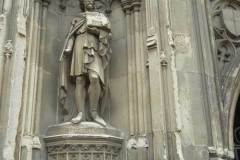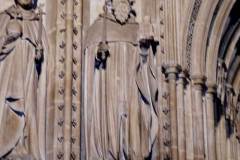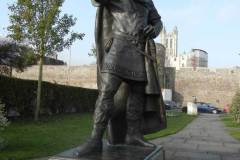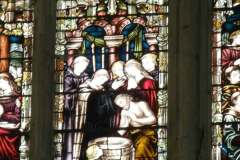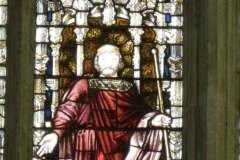First Christian King of Kent
Ethelbert was probably born around 560 and succeeded his father to the title of King of Kent in about 580. He died in 616. As King of Kent Ethelbert was ‘Bretwalda’, or Britain-ruler, as overlord in the east of England as far north as the river Humber. The marriage agreement that he made when he married Bertha, a French princess, allowed her to continue to practise her Christianity although Ethelbert was then a pagan. It is probable that Augustine’s mission to England in 597 was, in part, as a result of this marriage.
When Augustine landed on the Isle of Thanet a meeting was arranged with Ethelbert who insisted on it being outdoors as he was concerned that Augustine might ‘work his magic’ on him inside a building. The meeting was successful and Augustine and his followers were allowed to preach and baptise in Canterbury. Later Ethelbert was himself baptised and as a result gave his palace site for Augustine’s first church, this is now the cathedral. Meanwhile Ethelbert moved his palace 7 miles to the coast at Reculver.
With Ethelbert’s authority Augustine placed his Archbishop’s throne at Canterbury, not in London as ordered by Pope Gregory. The archbishop of Canterbury has remained the head of the Church of England ever since. But for this history Canterbury would not have the importance that it has today.
As a result, Ethelbert is commemorated with three statues, one outside the Cathedral’s porch carved in 1870 (Image 1) and another on the ‘Screen of the Six Kings’ in the centre of the cathedral dating from 1460 (Image 2). The third statue is modern and is to him and also Queen Bertha in Lady Wootton’s Green (LWG) (Image 3) showing the possible scene in 597 when the King meets Bertha as she returns from her prayers in St Martin’s church with the great news that Augustine has landed. The site of these statues is on the route that Bertha is thought to have taken. There is further information about the event and also the details of their clothing and accoutrements on storyboards by the statues. There are two stained glass windows depicting him in the Chapter House of the Cathedral. The first in the west window shows him being baptised (Image 4) and the second in the east window shows him standing (Image 5)
Ethelbert’s further claim to fame results from an entry in a document written over 500 years after his death. The Textus Roffensis is a 12th century document that contains the only copy of a set of laws laid down by Ethelbert. These laws are the first English laws ever written down and specify compensations that should be paid for particular offences; the penalties depended on who was the perpetrator and also who was the victim. For instance, theft from the King was to be fined nine times the value of the goods stolen and compensation for killing a freeman was 50 shillings to the king as overlord. Ethelbert and Bertha were also grandparents of Saint Eanswythe.
Access: Lady Wootton’s Green is a public square; for Cathedral charges apply
Sources: Storyboard on Lady Wootton’s Green; Wormald (2005)
AT

